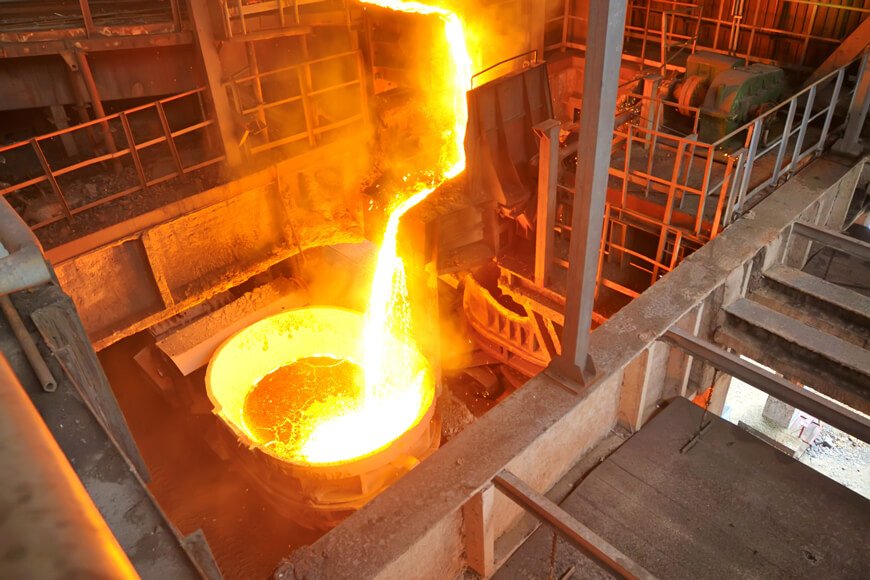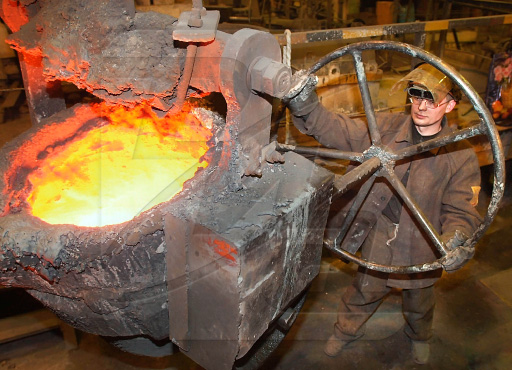Casting Foundry Insights: Predictions for the Next Decade
The Impact of Innovation on Effectiveness in the Casting Foundry Market
The Casting Foundry industry has experienced significant makeovers as a result of technical innovations. Automation and robotics have structured operations, boosting production rates while reducing errors. Furthermore, real-time monitoring and information analytics are improving decision-making processes, leading to extra efficient source administration. As these innovations remain to advance, they offer both obstacles and chances. Comprehending the full impact of these adjustments is essential for industry stakeholders to adjust and flourish in an affordable landscape.
The Function of Automation in Modern Foundries

These systems promote tasks such as mold development, putting, and cooling, enabling real-time surveillance and adjustments to optimize performance. Furthermore, automation makes it possible for shops to operate continuously, enhancing outcome and decreasing lead times.
The combination of automated options likewise supports better resource management, as equipments can be set to make use of products a lot more properly, decreasing waste. By applying automation, contemporary factories can adapt to fluctuating need, ensuring that they continue to be affordable in a quickly developing industry. Inevitably, automation represents a transformative pressure, redefining conventional Foundry practices and leading the method for future advancements.
Enhancing Quality Assurance Through Modern Technology
Innovation transforms quality control in factories, making sure that items satisfy stringent market standards. Advanced examination systems, such as laser scanning and 3D imaging, make it possible for precise dimension of actors components, recognizing problems at the earliest phases. These tools facilitate real-time surveillance of producing processes, enabling immediate modifications and lessening inconsistencies from high quality benchmarks.
Moreover, data analytics plays a crucial function in quality assurance by assessing patterns and predicting possible failures, which improves the dependability of the assembly line. Casting Foundry. Applying machine discovering formulas allows factories to constantly boost their quality guarantee procedures by picking up from historical information
In addition, the integration of electronic doubles allows online simulations of production procedures, permitting for thorough screening and validation prior to physical Casting occurs. Jointly, these technical developments not just boost the high quality of cast items however likewise bolster consumer fulfillment and trust in the factory's outcome.
Reducing Waste and Power Usage

In addition, the introduction of 3D printing innovation in mold and mildew development especially decreases material waste by enabling the manufacturing of complex styles without the need for extreme machining. Moreover, energy-efficient equipment and sustainable power resources are increasingly being embraced, adding to reduced functional prices and a smaller sized carbon footprint.
These technologies not only improve operational performance yet also promote lasting practices within the Casting Foundry market, straightening with worldwide initiatives to lower environmental impacts and improve resource management.
The Influence of Data Analytics on Choice Making
Data analytics has actually become an important device for improving decision-making procedures in casting foundries. By leveraging information gathered from numerous stages of production, shops can recognize ineffectiveness and areas for enhancement. As an example, real-time surveillance of equipment performance enables supervisors to make informed decisions regarding upkeep schedules, reducing downtime and optimizing outcome.
In addition, anticipating analytics assists projection need trends, making it possible for factories to adjust manufacturing levels accordingly and reduce excess inventory. This ability not just enhances procedures however additionally help in resource allocation, making sure that products are used efficiently.
Data-driven insights equip monitoring to evaluate the effectiveness of different alloys and products, leading to improved item top quality. As foundries increasingly adopt information analytics, the combination of these understandings into tactical decision-making procedures leads the means for enhanced functional efficiency and competitive advantage in the market.
Incorporating Robotics Into the Molding Refine
The assimilation of robotics into the molding procedure offers significant advantages for casting factories. By automating jobs, these systems can lower human mistake and improve production speed, causing a lot more reliable operations. As technology advances, the potential for robotics to transform traditional molding practices becomes progressively apparent.
Benefits of Robotic Automation
Robotic automation offers significant advantages in the molding process of casting foundries, improving both performance and accuracy. By making use of robotic systems, foundries can achieve greater manufacturing prices as a result of the regular rate and dependability of makers. These robots can carry out repetitive jobs with minimal downtime, which takes full advantage of and streamlines procedures result. In addition, the assimilation of robotics enables better versatility in manufacturing, allowing factories to promptly adjust to varying needs and complicated layouts. Moreover, robot automation adds to improved workplace safety and security by minimizing the requirement for human treatment in dangerous environments. Inevitably, the consolidation of robotics in the molding process results in maximized workflows, lowered operational prices, and improved item high quality in the Casting Foundry industry.
Decreasing Human Mistake
Human ability and instinct have actually traditionally played essential duties in the molding procedure, integrating robotics substantially reduces the danger of human mistake. Robotics offers precision and uniformity, ensuring more info here that each mold is check out this site developed with exact specs, reducing variability brought on by exhaustion or distraction amongst human drivers. With sophisticated sensing units and software, robotic systems can find abnormalities and make real-time adjustments, even more lessening the chance of problems. The automation of repeated jobs enables human workers to focus on even more facility responsibilities, enhancing general quality assurance. In enhancement, the application of robotics facilitates a more methodical method, causing standardization throughout manufacturing procedures, which is crucial for preserving top notch results in the Casting Foundry sector.
Enhancing Manufacturing Rate
Incorporating robotics right into the molding procedure not only decreases human error but also significantly enhances manufacturing speed within casting factories. By automating repeated tasks, robots can run continually, permitting for greater result rates compared to conventional approaches. Their precision warranties that mold and mildews are regularly filled, reducing downtime brought on by flaws or changes. Furthermore, robotics make it possible for quick adjustments in assembly line, suiting different layouts without substantial hold-ups. As an outcome, foundries can react a lot more quickly to market demands, increasing their affordable edge. Moreover, the integration of sophisticated robotics modern technologies enhances the process, maximizing resource allocation and minimizing labor prices. On the whole, the adoption of robotics in molding processes considerably thrusts efficiency and efficiency in the Casting Foundry industry.
Getting Over Challenges in Innovation Fostering

Future Patterns in Casting Foundry Modern Technology
What advancements exist ahead for the Casting Foundry market? The future of casting Foundry innovation is positioned for significant change via advancements such as 3D printing, automation, and fabricated intelligence. These developments assure to enhance precision and decrease waste in the Casting procedure. 3D printing enables the production of complicated geometries that typical techniques can not accomplish, while automation simplifies operations, boosting overall effectiveness. Furthermore, the integration of AI and artificial intelligence will assist in predictive upkeep, maximizing tools efficiency and minimizing downtime.
Furthermore, the pattern in the direction of lasting methods is anticipated to form the sector, with a concentrate on eco-friendly materials and procedures. Digital twins, which imitate real-world procedures, can also come to be commonplace, permitting factories to evaluate circumstances and make data-driven choices. Jointly, these improvements are readied to redefine the Casting Foundry landscape, driving efficiency and sustainability while meeting the advancing needs of different industries.
Frequently Asked Inquiries
Just How Does Modern Technology Impact Employee Roles in Foundries?
Technology significantly reshapes employee duties in factories by automating repeated tasks, enhancing accuracy, and necessitating brand-new ability collections. Employees increasingly concentrate on looking after sophisticated equipment and information analysis, bring about a change in work obligations and called for proficiencies.
What Are the Costs Related To Carrying Out New Technologies?
The costs of applying new technologies include initial financial investments, training expenses, recurring maintenance, and prospective disturbances during transition. Organizations should meticulously assess these economic elements to ensure successful combination and lasting long-lasting advantages.
Just How Can Little Shops Adopt Innovation Affordably?
To take on modern technology affordably, small foundries can check out gives, partnerships, and affordable remedies. Step-by-step upgrades, staff member training, and leveraging existing sources likewise improve performance without significant economic pressure, fostering gradual technological integration right into procedures.
What Skills Are Needed for Employees in Tech-Driven Foundries?
Workers in tech-driven factories call for abilities in information evaluation, maker procedure, and software proficiency. Additionally, adaptability to brand-new tools and innovations, problem-solving capacities, and cooperation with design groups are important for success in this advancing setting.
How Does Modern Technology Influence Safety And Security in Foundries?
Technology considerably boosts safety in factories by automating dangerous tasks, utilizing advanced monitoring systems, and helping with real-time communication. These developments decrease office mishaps and enhance emergency situation reaction, ultimately fostering a much safer setting for all workers.
Technology revolutionizes quality control in foundries, ensuring that items satisfy rigid market requirements. Innovations such as automated molding systems and innovative melting innovations allow foundries to optimize material usage and reduce energy needs. As the Foundry sector progressively acknowledges the benefits of arising innovations, conquering challenges in technology fostering becomes essential for boosting functional efficiency. Modern technology significantly reshapes employee functions in foundries by automating repetitive jobs, boosting accuracy, and requiring brand-new ability sets. Modern technology substantially boosts safety in shops by automating dangerous jobs, utilizing innovative monitoring systems, and assisting in real-time interaction.